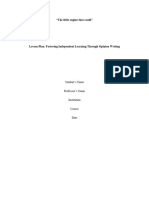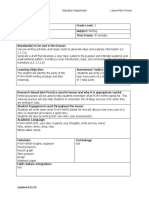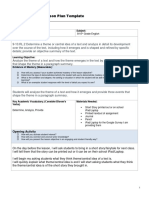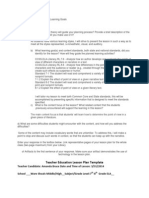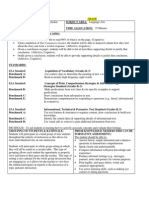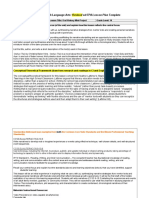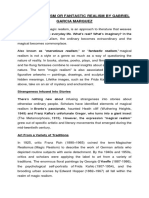Professional Documents
Culture Documents
Lesson Plan Day 3
Lesson Plan Day 3
Uploaded by
api-317730714Original Description:
Original Title
Copyright
Available Formats
Share this document
Did you find this document useful?
Is this content inappropriate?
Report this DocumentCopyright:
Available Formats
Lesson Plan Day 3
Lesson Plan Day 3
Uploaded by
api-317730714Copyright:
Available Formats
SAUSD Common Core Lesson Planner
Unit: Fables
Lesson #: 2
Common Core
and Content
Standards
Materials/
Resources/
Lesson
Preparation
Grade Level/Course:
3rd Grade
Teacher: Ms. Ramirez
Duration: _Day 3, 4 and 5_
Writing
CCSS.ELA-LITERACY.W.3.3
Write narratives to develop real or imagined experiences or events using effective technique, descriptive
details, and clear event sequences.
CCSS.ELA-LITERACY.W.3.3.A
Establish a situation and introduce a narrator and/or characters; organize an event sequence that unfolds
naturally.
CCSS.ELA-LITERACY.W.3.3.B
Use dialogue and descriptions of actions, thoughts, and feelings to develop experiences and events or show
the response of characters to situations.
CCSS.ELA-LITERACY.W.3.4
With guidance and support from adults, produce writing in which the development and organization are
appropriate to task and purpose.
CCSS.ELA-LITERACY.W.3.5
With guidance and support from peers and adults, develop and strengthen writing as needed by planning,
revising, and editing.
CCSS.ELA-LITERACY.W.3.6
With guidance and support from adults, use technology to produce and publish writing (using keyboarding
skills) as well as to interact and collaborate with others
Language
CCSS.ELA-LITERACY.L.3.1
Demonstrate command of the conventions of standard English grammar and usage when writing or
speaking.
CCSS.ELA-LITERACY.L.3.1.B
Form and use regular and irregular plural nouns.
CCSS.ELA-LITERACY.L.3.1.D
Form and use regular and irregular verbs.
CCSS.ELA-LITERACY.L.3.1.E
Form and use the simple (e.g., I walked; I walk; I will walk) verb tenses.
CCSS.ELA-LITERACY.L.3.1.I
Produce simple, compound, and complex sentences.
CCSS.ELA-LITERACY.L.3.2
Demonstrate command of the conventions of standard English capitalization, punctuation, and spelling
when writing.
CCSS.ELA-LITERACY.L.3.2.C
Use commas and quotation marks in dialogue.
CCSS.ELA-LITERACY.L.3.2.D
Form and use possessives.
Speaking and Listening
CCSS.ELA-LITERACY.SL.3.1.A
Come to discussions prepared, having read or studied required material; explicitly draw on that preparation
and other information known about the topic to explore ideas under discussion.
Aesops The Boy Who Cried Wolf
(http://www.eastoftheweb.com/short-stories/UBooks/BoyCri.shtml)
Narrative writing guidelines and rubric
SAUSD Common Core Lesson Template
Objectives
Depth of
Knowledge
Level
Content:
Students will continue learning about
fables. Inspiration will be taken from The
Boy Who Cried Wolf to create and write a
narrative story.
Level 1: Recall
Level 3: Strategic Thinking
Language:
Students will continue to build their vocabulary.
During students writing new vocabulary will be
encouraged to be incorporated into their narratives.
Students will demonstrate sequence of events in their
writing as well.
Level 2: Skill/Concept
Level 4: Extended Thinking
Demonstrating independence
Building strong content knowledge
College and
Career Ready
Skills
Responding to varying demands of audience, task, purpose, and discipline
Comprehending as well as critiquing
Valuing evidence
Using technology and digital media strategically and capably
Coming to understand other perspectives and cultures
TEACHER PROVIDES
SIMPLE EXPLANATION
STUDENTS
MEANING FIGURE OUT
THE
(Tier II & Tier III)
Academic Vocabulary
Common Core
Instructional
Shifts
Pre-teaching
Considerations
CCSS
Foundational
Standards
(K-5 only)
Building knowledge through content-rich nonfiction texts
Reading and writing grounded from text
Regular practice with complex text and its academic vocabulary
KEY WORDS ESSENTIAL TO
WORDS WORTH KNOWING
UNDERSTANDING
Heed, rendered, leisure, lacerated
Agony
Flock, truly, alarmed, assistance,
Village, terror
Have students written narratives before, and do they understand how to write a narrative?
CCSS.ELA-LITERACY.RI.3.1
Ask and answer questions to demonstrate understanding of a text, referring explicitly to the text as the basis
for the answers.
CCSS.ELA-LITERACY.RI.3.2
Determine the main idea of a text; recount the key details and explain how they support the main idea.
CCSS.ELA-LITERACY.RI.3.8
Describe the logical connection between particular sentences and paragraphs in a text (e.g., comparison,
SAUSD Common Core Lesson Template
cause/effect, first/second/third in a sequence).
Instructional
Methods
What moral lesson did we learn from the assigned homework, The Boy Who Cried Wolf?
(HW: Visit the class website and follow the link {http://www.eastoftheweb.com/shortstories/UBooks/BoyCri.shtml} located in the Fables Unit Plan page. Read Aesops The Boy
Who Cried Wolf and participate in the online class discussion board. Write and post a question
that you have about the story or something that you found interesting. Also, find three words that
you did not know and look up their meaning. Post the words and definitions online as well. )
Review key vocabulary: Pull up the classrooms online discussion board on the digital projector
and review popular words that students did not know along with their posted definitions. At this
time also clarify any questions that students may have posted.
Lesson Continuum
Less
on
Ope
ning
Lesson Delivery
Check method(s) used in the lesson:
Modeling
Guided Practice
Collaboration
Independent Practice
Guided Inquiry
Reflection
Check on previous knowledge: Do students remember the moral lesson learned from The
Tortoise and the Hare?
SAUSD Common Core Lesson Template
Differentiated Instruction:
Questioning/Engagement/Writing/Checking for Understanding
Activities/Tasks/ Strategies/Technology/
1.
Teacher
Reflection
Evidenced
by Student
Learning/
Outcomes
2.
3.
4.
5.
6.
7.
8.
9.
Discuss the moral lesson in The Boy Who Cried Wolf - There is no
believing a liar, even when he speaks the truth.
Do you agree or disagree with the statement?
Have you or someone you know ever been in a similar situation?
Introduce the narrative writing assignment: Think about a time you lied (this
can be real or imagined). What was the consequence of that lie? What
happened? Think about the sequence of events that led to the lie or to the
consequence of that lie. Write a narrative story about this experience.
Students will brainstorm at least three ideas for the writing assignment. Walk
around and offer guidance as necessary. Provide students with a bubble
brainstorm sheet to motivate them and have them write everything that
comes to mind.
Student will have to narrow their ideas down to one, the one experience that
they will be writing about. If students are having a difficult time choosing, a
few minutes will be allowed to partner up and ask for their partners advice.
Once everyone has a topic, ask students to write down:
What characters will be included in their narrative?
What details are important to their story?
What will they open their story with and what will they close their story
with?
A few of the new words we have discussed in class during the Fables Unit
that they may want to include into their narrative.
Allow students to work on a rough draft of their narrative story. Emphasize
the importance of having a clear sequence of events.
Monitored group work (formative assessment): After students have written a
rough draft, pass out copies of the writing assignment rubric. Partner
students up to peer review each others rough drafts to encourage student
collaboration. Have them use the rubric as guidance. Walk around and listen
to students input and discussions. Also, observe who is participating.
English Learners:
Spend one-on-one time
explaining the narrative
writing assignment to them.
Be available to them, but
also pair them up with a
classmate that can help
them successfully.
Special Needs:
When explaining directions
talk at an appropriate pace.
Pair them with someone
who will be able to explain
simple vocabulary if
necessary.
Accelerated Learners:
Daily homework: Remind students of their collaborative presentation.
Receive confirmation from students on what groups are established. Email
parents of the group project (summative assessment) students have. Have
group presentation directions available on the class website. Encourage
student participation and collaboration, and let them be aware that I am
available if there are questions or problems. Presentations will be done at the
end of the unit.
Weekend homework:
Students will type up a final copy of their narrative. In addition, a descriptive
drawing or digital picture will be required. Creativity will be encouraged.
Online quiz (formative assessment): Have students complete a short online
quiz, which I will use to check for understanding of the unit. Students will be
allowed to take the quiz twice so that they can check for understanding
themselves. Online quiz will allow students flexibility.
Lesson Reflection
I will use my group work observation to guide the way I partner students up next time, keeping in
mind who was following the rubric guidelines and offering helpful feedback to classmates. Also, I
will use the information I gather from the online quiz results to shape my next lesson.
SAUSD Common Core Lesson Template
SAUSD Common Core Lesson Template
You might also like
- Fallout Quickstart RulesDocument61 pagesFallout Quickstart RulesAnika P100% (2)
- Freedom Writers 3 Lesson PlansDocument8 pagesFreedom Writers 3 Lesson Planssewilliams31100% (2)
- Advice To Youth by Mark TwainDocument6 pagesAdvice To Youth by Mark TwainEmmanuel EndrigaNo ratings yet
- Capcom Vs SNK 2, Move ListDocument77 pagesCapcom Vs SNK 2, Move ListEmerson SamboNo ratings yet
- The Medium of Fiction - William GassDocument7 pagesThe Medium of Fiction - William GassDestino YI LuNo ratings yet
- Lesson Plan Day 6Document4 pagesLesson Plan Day 6api-317730714No ratings yet
- Grade 2 Explicit Instruction Personal Narrative Writing UnitDocument42 pagesGrade 2 Explicit Instruction Personal Narrative Writing UnitRoopaliSharma100% (2)
- Millicent Atkins School of Education: Common Lesson Plan TemplateDocument34 pagesMillicent Atkins School of Education: Common Lesson Plan Templateapi-383013037No ratings yet
- Lesson PlanDocument11 pagesLesson Planobrowser12No ratings yet
- Bridging: MSMU Lesson Plan FormatDocument7 pagesBridging: MSMU Lesson Plan Formatapi-547294586No ratings yet
- 6 ThgradelessonplanDocument5 pages6 Thgradelessonplanapi-250804267No ratings yet
- Unit Overview Essay WritingDocument15 pagesUnit Overview Essay Writingapi-253198705100% (1)
- Camera Writing LessonDocument1 pageCamera Writing Lessonapi-235706970No ratings yet
- Ela Lesson Plan - Persuasive Language - 4th GradeDocument5 pagesEla Lesson Plan - Persuasive Language - 4th Gradeapi-316613434No ratings yet
- Understanding by Design Unit TemplateDocument5 pagesUnderstanding by Design Unit Templateapi-318155534No ratings yet
- 4th Observation Lesson About WritingDocument4 pages4th Observation Lesson About Writingapi-597953642No ratings yet
- Lesson Plan Day 1Document4 pagesLesson Plan Day 1api-317730714No ratings yet
- Concordia University Nebraska Education Department Lesson Plan FormatDocument3 pagesConcordia University Nebraska Education Department Lesson Plan Formatapi-486716938No ratings yet
- Expository Lesson PlanDocument6 pagesExpository Lesson Planapi-265180782100% (1)
- Content Standard(s) Addressed by This Lesson:: STEPP Lesson Plan FormDocument6 pagesContent Standard(s) Addressed by This Lesson:: STEPP Lesson Plan Formapi-282071507No ratings yet
- Usa Lesson PlanDocument4 pagesUsa Lesson Planapi-339541084No ratings yet
- Sarah King Lesson Plan R3Document4 pagesSarah King Lesson Plan R3Sarah KingNo ratings yet
- Lessonplan 1Document6 pagesLessonplan 1api-286533325No ratings yet
- Reading and Writing. Lesson 3Document5 pagesReading and Writing. Lesson 3Rayle ParconNo ratings yet
- Tech Integration PlanDocument5 pagesTech Integration PlanJuan SorianoNo ratings yet
- Krystinastump Edr628curriculumprojectDocument21 pagesKrystinastump Edr628curriculumprojectapi-285773334No ratings yet
- Lesson Plan #1 1. Descriptive DataDocument16 pagesLesson Plan #1 1. Descriptive Dataapi-220232621No ratings yet
- Digital Unit Plan Template 1Document5 pagesDigital Unit Plan Template 1api-451164539No ratings yet
- Direct Instruction Lesson Plan-1 2Document4 pagesDirect Instruction Lesson Plan-1 2api-532851463No ratings yet
- PD Calender 3 Year OutlineDocument4 pagesPD Calender 3 Year Outlineapi-237659400No ratings yet
- CEP Lesson Plan Form: CCSS - ELA-Literacy - RL.9-10.3Document11 pagesCEP Lesson Plan Form: CCSS - ELA-Literacy - RL.9-10.3api-309656697No ratings yet
- USF Elementary Education Lesson Plan Template: Read Aloud Name: - Lourdes - Rocha - Grade Level Being Taught: - 3rd - Date of Lesson: - 3/27/2019Document6 pagesUSF Elementary Education Lesson Plan Template: Read Aloud Name: - Lourdes - Rocha - Grade Level Being Taught: - 3rd - Date of Lesson: - 3/27/2019api-449298895No ratings yet
- Ppat Section 3Document8 pagesPpat Section 3api-237235020No ratings yet
- Crafting A Creative Fiction Unit PlanDocument14 pagesCrafting A Creative Fiction Unit Planapi-283336660No ratings yet
- Mce Lesson PlanDocument2 pagesMce Lesson Planapi-436993644No ratings yet
- Week TwoDocument41 pagesWeek Twoapi-285025959No ratings yet
- 1st Lesson Plan... The Community Garden..Document6 pages1st Lesson Plan... The Community Garden..OvalCatNo ratings yet
- TPCK Lee PetrosDocument5 pagesTPCK Lee Petrosapi-302439101No ratings yet
- Formal Lesson Plan Template: Measurable, and RealisticDocument3 pagesFormal Lesson Plan Template: Measurable, and Realisticapi-285995221No ratings yet
- Lesson Plan Template: NEPF + Components of An Effective Lesson HybridDocument4 pagesLesson Plan Template: NEPF + Components of An Effective Lesson Hybridapi-286066914No ratings yet
- Early Childhood Program Lesson Plan Format Junior SpringDocument12 pagesEarly Childhood Program Lesson Plan Format Junior Springapi-508716116No ratings yet
- AP Language and CompDocument10 pagesAP Language and Compnstearns100% (2)
- Second Lesson OpinionDocument5 pagesSecond Lesson Opinionapi-450830120No ratings yet
- Lae 3333 - Chapter 3 PresentationDocument14 pagesLae 3333 - Chapter 3 Presentationapi-273356222No ratings yet
- Edla204 - Where The Wild Things Are Standard 3Document8 pagesEdla204 - Where The Wild Things Are Standard 3api-357949761No ratings yet
- Small Group Lesson PlanDocument24 pagesSmall Group Lesson Planapi-205969604No ratings yet
- Favreau Writing LessonDocument7 pagesFavreau Writing Lessonapi-380761761No ratings yet
- 7 Week 2 (August 22-24, 2023)Document4 pages7 Week 2 (August 22-24, 2023)Justine B. CalicaNo ratings yet
- Sharon Cuevas - Unit Plan Template-1Document8 pagesSharon Cuevas - Unit Plan Template-1api-552632514No ratings yet
- Lesson Plan Recognizing AudienceDocument21 pagesLesson Plan Recognizing AudienceCPaulE33No ratings yet
- Grade Level: 4 Lesson Duration: 2 Hours: "Three Young Pilgrims" Poetry Challenge MOPTA Lesson Plan FormatDocument19 pagesGrade Level: 4 Lesson Duration: 2 Hours: "Three Young Pilgrims" Poetry Challenge MOPTA Lesson Plan Formatapi-341318966No ratings yet
- Sarahsmith LessonmakeoverassignmentDocument4 pagesSarahsmith Lessonmakeoverassignmentapi-299188221No ratings yet
- 2 11 Aunt SusanDocument4 pages2 11 Aunt Susanapi-308910909No ratings yet
- Module-4 (Te2)Document12 pagesModule-4 (Te2)Joanne LorenzoNo ratings yet
- Interactive NotebookDocument13 pagesInteractive Notebookapi-438474588No ratings yet
- BarryunitplanfinalDocument7 pagesBarryunitplanfinalapi-551107380No ratings yet
- Ci 403 Unit Plan LP 5Document9 pagesCi 403 Unit Plan LP 5api-302766620No ratings yet
- Cep Lesson Plan Feb 29th Breaking BarriersDocument6 pagesCep Lesson Plan Feb 29th Breaking Barriersapi-282071507No ratings yet
- ESL Practicum Lesson PlanDocument5 pagesESL Practicum Lesson Planapi-404665962No ratings yet
- Assessment Task 5: Evidence of Learning: 4163 Cambridge International Award in Teaching and LearningDocument2 pagesAssessment Task 5: Evidence of Learning: 4163 Cambridge International Award in Teaching and LearningkrisnuNo ratings yet
- Direct Instruction Lesson Plan Template: Kerny Hanson - Resident 8th Grade Honors ELADocument3 pagesDirect Instruction Lesson Plan Template: Kerny Hanson - Resident 8th Grade Honors ELAapi-487904263No ratings yet
- Literacy Plan Term 2 Yr 5 2013Document5 pagesLiteracy Plan Term 2 Yr 5 2013mrslockyerNo ratings yet
- Fairy TalesDocument3 pagesFairy TalesBe Haj100% (1)
- The Beast Within: A Look at The Representation of Animals in Victorian LiteratureDocument10 pagesThe Beast Within: A Look at The Representation of Animals in Victorian LiteratureCarolina Estela Fragoso ColónNo ratings yet
- Magical Realism or Fantastic Realism by Gabriel Garcia MarquezDocument9 pagesMagical Realism or Fantastic Realism by Gabriel Garcia Marquezshahbaz0% (1)
- Puck MonologueDocument1 pagePuck MonologuePrice MarshallNo ratings yet
- Frankenstein PresentationDocument21 pagesFrankenstein Presentationwafuladerick40No ratings yet
- 04 POE-the Fall of The House of Usher + The RavenDocument21 pages04 POE-the Fall of The House of Usher + The Ravenvj9jyyjkhqNo ratings yet
- Critic PaperDocument2 pagesCritic PaperMeagan Carl JapzonNo ratings yet
- 5 Socialist Realism vs. Fairy Tales 2023Document24 pages5 Socialist Realism vs. Fairy Tales 2023shawn johnsonNo ratings yet
- Repaso Ingles 1 Bachillerato - CompletoDocument15 pagesRepaso Ingles 1 Bachillerato - CompletoCarlota Almeida Garcia100% (1)
- Prepositions Sec 1Document7 pagesPrepositions Sec 1Madhur SinghNo ratings yet
- Doctor FaustusDocument5 pagesDoctor FaustusParul SoniNo ratings yet
- To Kill A Mockingbird 12-16 QuizDocument3 pagesTo Kill A Mockingbird 12-16 QuizJess Ma100% (1)
- Room 204 Update - February 23, 2014 Spring Street School Mrs. Liporto's ClassDocument3 pagesRoom 204 Update - February 23, 2014 Spring Street School Mrs. Liporto's ClassKristen Pietrowski LiportoNo ratings yet
- Pyramid - Suppressed Transmission - There's More To Faeries Than Their GlamourDocument4 pagesPyramid - Suppressed Transmission - There's More To Faeries Than Their GlamourJaaZZ ZooNo ratings yet
- 2005 Freewrite AP Lit Essay Question: 2005, Form BDocument1 page2005 Freewrite AP Lit Essay Question: 2005, Form BangelaNo ratings yet
- English AuthorsDocument4 pagesEnglish AuthorsRodelNo ratings yet
- Femme Fatales v01n03Document68 pagesFemme Fatales v01n03marceloNo ratings yet
- Cultural TranslationDocument11 pagesCultural TranslationEmma Fauziah100% (1)
- Philippine Literature: in Pre-Colonial PeriodDocument98 pagesPhilippine Literature: in Pre-Colonial PeriodAbegail RuinNo ratings yet
- The Ten Most Important Books To Expand Your Brain PDFDocument7 pagesThe Ten Most Important Books To Expand Your Brain PDFSantosh KodereNo ratings yet
- Pride & Prejudice EssayDocument3 pagesPride & Prejudice EssayCristianNo ratings yet
- Verb Tense ExerciseDocument9 pagesVerb Tense Exercisenickfreed100% (1)
- The Indefinite Article Aoran - Ed (-And Write How It Is Pronounced)Document1 pageThe Indefinite Article Aoran - Ed (-And Write How It Is Pronounced)IonicutaNo ratings yet
- Unrequited Love EssayDocument6 pagesUnrequited Love Essayapi-410544557No ratings yet
- RRJ 6Document3 pagesRRJ 6api-273267524No ratings yet
- s2014 Syllabus Atec 4373 (RPG)Document2 pagess2014 Syllabus Atec 4373 (RPG)albrackinNo ratings yet
- Ghosts in Bengali Culture - WikipediaDocument22 pagesGhosts in Bengali Culture - WikipediaSHAMIM AHAMEDNo ratings yet








